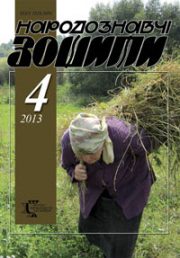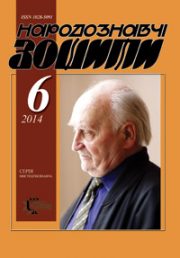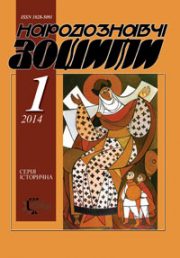The Ethnology Notebooks. 2017, 4 (136), 977–982
UDK 747:72.012.8:728.5 (47725).”1950/1980”
DOI https://doi.org/10.15407/nz2017.04.977
Smoliar Olena — a graduate student of the Kyiv national university culture and arts
department of design of advertisement and environment, works
in Department of culture of Kyiv.
boulevard Shevchenko, 3, Kyiv, 01004, Ukraine
Contacts: telephone: (044) 279-61-09
e-mail: dk@kievcity.gov.ua
Abstract. The article examines conceptual analysis of the artworks of monumental and decorative art in interior design of the hotels in Kiev 1950—1980th.The main task of the wall ar of studied period was to bring the wall ideas that have a clear and understandable dialogue with the people. Artists sought to fill the public interiors to appeal friendliness, social harmony, patriotism to their country, the worship of nature, achieving the desired result by the talent of creative ideas. Compositional story by means of monumental decoration for decades is rapidly growing, bewitching with its originality of thematic solutions. Based on the study of monumental and decorative artworks of the above mentioned period, this art, with its profound meaning and concepts, becomes a model for the formation of new interior objects of hotel facilities in Kiev. This can become a salvation for questions of the reconstruction and preservation of architectural monuments of our homeland, as well as the creation of new hotels interior projects with the concepts of our period of the 2000s, which is very important, sublime motives that remain in the history of Ukraine.
Keywords: monument and decorative art, artwork, design, interior hotels, composition, conception.
Received 27.06.2017
REFERENCES
Zhogol’, L. E. (1978). Dekorativnoe iskusstvo v inter’erah obshhestvennyh zdanij. Kiev: Budivel’nik [in Russian].
Zhogol’, L. E. (1986). Dekorativnoe iskusstvo v sovremennom inter’ere. Kiev: Budivel’nik [in Russian].
Zadorozhnij, I.-V. (1991). Zadorozhnij IvanValentyn: monumental’ne mystetstvo, zhyvopys, hrafika. Kataloh vystavky tvoriv. Kyiv: Spilka khudozhnykiv Ukrainy [in Ukrainian].
Kantor, A. (1980). Samocennost’ iskusstva i perezhivanie prostranstva. Moskva: Dekorativnoe iskusstvo SSSR. Vyp. № 12. S. 14 [in Russian].
Lebedeva, V. E. (1973). Sovetskoe monumental’noe iskusstvo shestidesjatyh godov. Moskva: Nauka [in Russian].
Mysiuha, B. V. (2011). Halyna Sevruk. Al’bommonohrafiia. L’viv; Kyiv: Smoloskyp [in Ukrainian].
Skliarenko, H. Ya. (1987). Mystetstvo i misto. Rol’ monumental’no-dekoratyvnoho mystetstva u formuvanni estetychnoho seredovyscha sotsialistychnoho mista. Literatura i mystetstvo. Seriia 6. Vyp. № 9 [in Ukrainian].
Chehusova, Z. A. (2008). Liudmyla Zhohol’: Charivnytsia khudozhn’oho tekstyliu. Z. A. Chehusova, T. V. KaraVasyl’ieva& T. O. Prydatko. Kyiv: Lybid’ [in Ukrainian].
Retrieved from: http://okeramike.ru/books/item/f00/s00/z0000005/st008.shtml [in Ukrainian].







